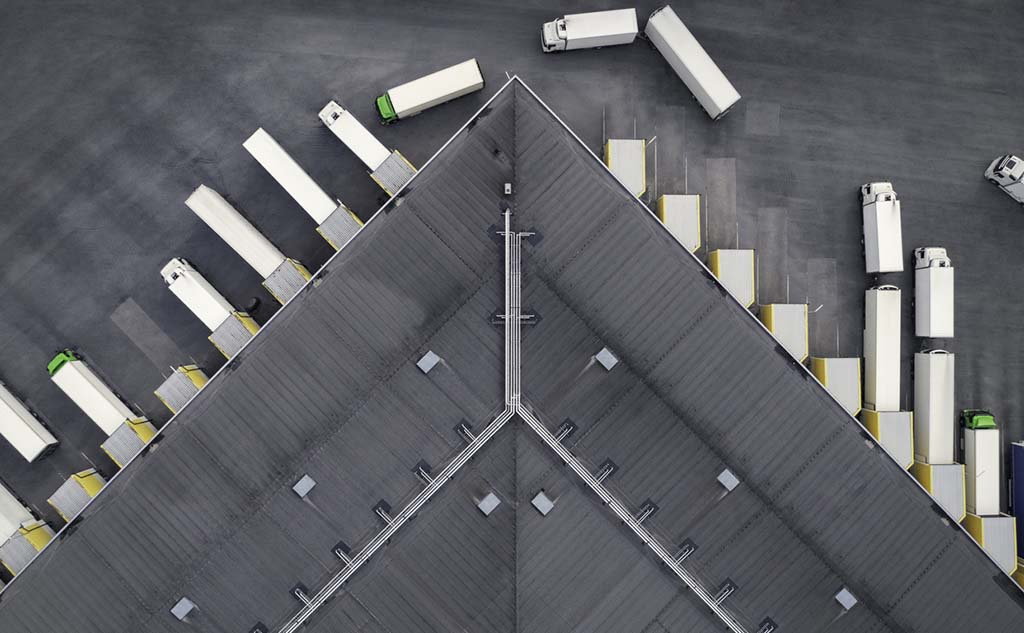Providing significant support for business, the logistics industry is undergoing huge transformations: supply chains are being digitised and automated and the industry is becoming increasingly aware of its responsibilities regarding the environment and climate change. This is particularly the case for urban logistics, which finds itself at the crossroads of numerous regional planning issues.
Urban logistics: an essential activity…
Urban logistics covers everything to do with the overall management of flows in the urban environment: transport, storage, packing, order and returns management, pallet and packaging materials management, delivery and collection, and dedicated infrastructure (warehouses, platforms, pick-up points, etc.). That makes it a central pillar of town’s and cities’ functioning and drive, and goes far beyond mere e-commerce since every type of flow is involved: indeed, according to estimates, 50% of flows relate to households, 40% to business and 10% to urban management (waste, construction, removals, etc.).
… with a range of impacts
However, as with any economic activity, urban logistics has various impacts on the environment, climate and health: transport-related CO2, NOx and fine particle emissions, road congestion and conflict of use, noise pollution, land use and more, and is responsible for 30% of greenhouse gas emissions, 40% of fine particle emissions and 50% of urban diesel and consumption.
Ever more complex supply chains
We are today seeing supply chains becoming increasingly complex. With the growth in e-commerce, which began before the pandemic but has been greatly amplified since, the types of merchandise delivered are becoming increasingly diverse with all that this implies in terms of adaptation (e.g. fresh food). At the same time delivery channels and goods hubs have both increased in number, while faced with ever more demanding delivery requirements, delivery hours are extending. Not forgetting the question of returns, which have practically become the norm.
What concrete solutions are available?
All these developments call for new types of logistical organisation and more suitable multimodal interfaces. Although different methodologies and sector charters are emerging(1), the real transformation of supply chains involves several types of solution, particularly in the fields of digitisation and decarbonisation.
Digitisation and data management are essential for developments such as the regulation and control of use of drop-off points, pooling of flows, delivery round optimisation (speed and traceability of deliveries) and of course operational automation. Developments in all these fields are both numerous and fast. For example several companies (e.g. Navya, Outrider, EasyMile, etc.) are producing self-driving tugs that bring together driverless mobility, management software and connected systems. Other solutions should emerge with the announcement of the winners of the France Relance (French government programme aimed at relaunching the country’s economy after the COVID pandemic) “Logistic 4.0” request for proposals, one of main themes of which is supply chain digitisation(2).
The decarbonisation, and more generally, the greening of logistics operations involves use of low-emission vehicles (electric or hydrogen-fuelled), the development of bicycle logistics (“cargo bikes”), the deployment of pooling, storage in environmentally-friendly buildings (HQE, BREEAM, LEED), etc. Faced with all this, the development of charging infrastructure and the improvement of logistics facilities accessible to cargo bikes become very important. Other key points in supply chain optimisation include the setting-up of local distribution networks, deployment of reverse logistics and the installation of mobile hubs.
Solar panel installation on warehouses: an operation with many benefits
Opting to install PV panels on a logistics warehouse roof helps reduce its carbon footprint. It also helps reduce the site’s energy costs. And today these costs, already strongly affected by the increase in activity and process robotization, continue to rise due to the current geopolitical situation. Finally, another interesting aspect is that installing solar panels on a warehouse contributes to achieving the French government’s ZAN (Zero Net Land Take) objective set for 2050, since this avoids taking land for solar power generation (as well as making it possible to build a warehouse on waste land).
In the end, although not all of France’s 78 million m2 of warehousing can participate (the structures of some of the oldest buildings will not take the weight of the panels), the potential on existing buildings is considerable. In addition, there is a new obligation in France for at least 30% of the roofs of new buildings covering over 1,000 m2 to be covered by either vegetation or photovoltaic panels (‘Energy-Climate’ law dated 2019).
And tomorrow?
Delivery by drone, still merely a curiosity in France, is developing rapidly elsewhere (USA, Germany, etc.). In addition to technical adjustments, this will require the introduction of an entire regulatory and legal framework. In the same way, always with the objective of minimising road network load, some are suggesting underground delivery systems, while others are working on systems that would couple passenger and goods transport over cities, for example SupraWays which is developing a system of driverless aerial cabins.
Generally speaking, although numerous solutions already exist to render urban logistics more sustainable, their deployment will require sustained collaboration between local authorities and companies. That’s the goal of a guide published at the end of 2021 by ETP Alice and Polis Network(3).
1) Ex.: Interlud Programme – Regional innovations and sustainable urban logistics, by ADEME (the French Agency for Ecological Transition), CEREMA (French public agency for developing public expertise in the fields of urban planning, regional cohesion and ecological and energy transition), CGI (French IT company), LLC (Logistic Low-Carbon) and Rozo (energy efficiency consultants) until 31/12/2022; Reciprocal Commitment Charter between the State and members of Afilog (French Association for Logistics Properties) for the environmental and economic performance of French logistics facilities (July 2021); Charter of commitments for the reduction of the environmental impact of e-commerce (July 2021), etc.
2) The “Logistics 4.0” Request for Proposals is part of the strategy aiming to accelerate the “digitisation and decarbonisation of transport”, and particularly of its theme “Optimise, secure and decarbonise mass transport and multimodal interfaces”. The winners should be announced by the end of 2022.
3) “Guide for Advancing towards Zero-emission Urban Logistics by 2030”, by ETP Alice (Alliance for Logistics Innovation through Collaboration in Europe) and Polis Network (Cities and Regions for Transport Innovation), December 2021, downloadable from www.etp-logistics.eu




